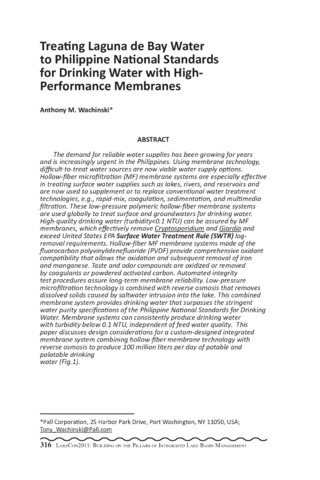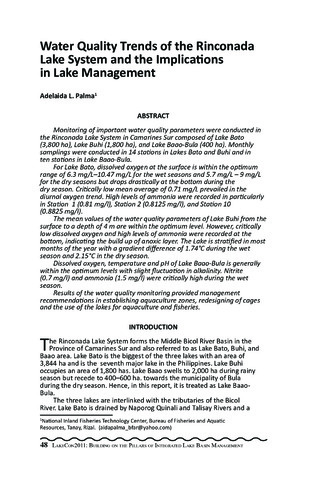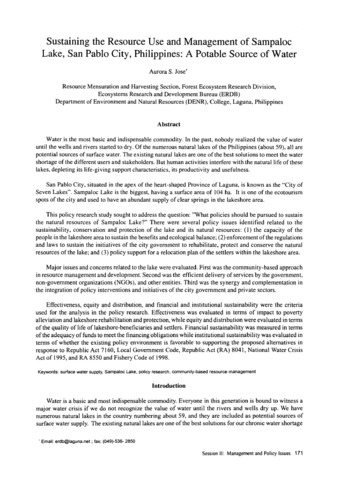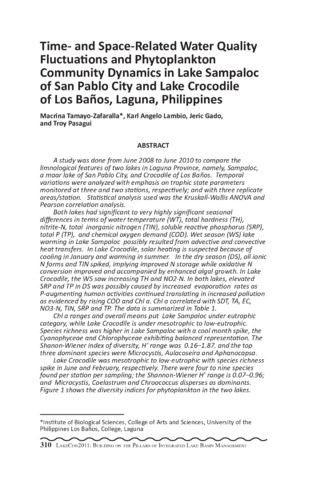Treating Laguna de Bay water to Philippine National Standards for drinking water with high-performance membranes
- Global styles
- MLA
- Vancouver
- Elsevier - Harvard
- APA
- Help
Share
抄録
The demand for reliable water supplies has been growing for years and is increasingly urgent in the Philippines. Using membrane technology, difficult-to-treat water sources are now viable water supply options. Hollow-fiber microfiltration (MF) membrane systems are especially effective in treating surface water supplies such as lakes, rivers, and reservoirs and are now used to supplement or to replace conventional water treatment technologies, e.g., rapid-mix, coagulation, sedimentation, and multimedia filtration. These low-pressure polymeric hollow-fiber membrane systems are used globally to treat surface and groundwaters for drinking water. High-quality drinking water (turbidity<0.1 NTU) can be assured by MF membranes, which effectively remove Cryptosporidium and Giardia and exceed United States EPA Surface Water Treatment Rule (SWTR) logremoval requirements. Hollow-fiber MF membrane systems made of the fluorocarbon polyvinylidenefluoride (PVDF) provide comprehensive oxidant compatibility that allows the oxidation and subsequent removal of iron and manganese. Taste and odor compounds are oxidized or removed by coagulants or powdered activated carbon. Automated integrity test procedures assure long-term membrane reliability. Low-pressure microfiltration technology is combined with reverse osmosis that removes dissolved solids caused by saltwater intrusion into the lake. This combined membrane system provides drinking water that surpasses the stringent water purity specifications of the Philippine National Standards for Drinking Water. Membrane systems can consistently produce drinking water with turbidity below 0.1 NTU, independent of feed water quality. This paper discusses design considerations for a custom-designed integrated membrane system combining hollow-fiber membrane technology with reverse osmosis to produce 100 million liters per day of potable and palatable drinking water (Fig.1).
Suggested Citation
Wachinski, A. M. (2013). Treating Laguna de Bay water to Philippine National Standards for drinking water with high-performance membranes. In M. L. C. Aralar, A. S. Borja, A. L. Palma, M. M. Mendoza, P. C. Ocampo, E. V. Manalili, & L. C. Darvin (Eds.), LakeCon2011: Building on the pillars of Integrated Lake Basin Management (Second National Congress on Philippine Lakes) (pp. 316-317). Los Baños, Laguna, Philippines: PCAARRD-DOST.
Type
Conference paperISSN
1656-8099シリーズ
Summary of Proceedings No. 1/2013;Collections
- LakeCon2011 [30]
Related items
Showing items related by title, author, creator and subject.
-
Series: Summary of Proceedings No. 1/2013;
Water quality trends of the Rinconada lake system and the implications in lake management
Palma, Adelaida L. (PCAARRD-DOST, 2013)Monitoring of important water quality parameters were conducted in the Rinconada Lake System in Camarines Sur composed of Lake Bato (3,800 ha), Lake Buhi (1,800 ha), and Lake Baao-Bula (400 ha). Monthly samplings were ... -
Sustaining the resource use and management of Sampaloc Lake, San Pablo City, Philippines: A potable source of water
Jose, Aurora S. (Southeast Asian Regional Center for Graduate Study and Research in Agriculture (SEARCA), 2005)Water is the most basic and indispensable commodity. In the past, nobody realized the value of water until the wells and rivers started to dry. Of the numerous natural lakes of the Philippines (about 59), all are potential ... -
Series: Summary of Proceedings No. 1/2013;
Time- and space-related water quality fluctuations and phytoplankton community dynamics in Lake Sampaloc of San Pablo City and Lake Crocodile of Los Baños, Laguna, Philippines
Tamayo-Zafaralla, Macrina; Lambio, Karl Angelo; Gado, Jeric; Pasagui, Troy (PCAARRD-DOST, 2013)A study was done from June 2008 to June 2010 to compare the limnological features of two lakes in Laguna Province, namely, Sampaloc, a maar lake of San Pablo City, and Crocodile of Los Baños. Temporal variations were ...






